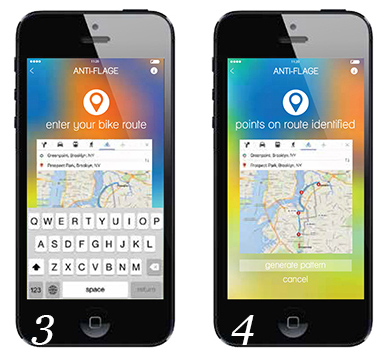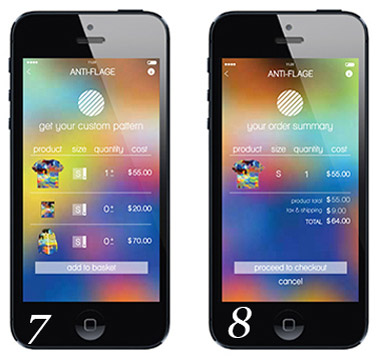
Anti-Flage is a method that aims to achieve a custom, hyper-contrasting pattern that will ensure visibility on your bike route. Over the years, cyclist fatalities and accidents have risen due to the lack of visibility. These accidents mainly occur between 4pm and 8pm - the twilight zone - and during rush hour. To help reduce these casualties, we set out to research ways to to design a product that would help give bikers better visibility at dusk.
We started with understanding the market of readily available reflective clothing, however, quickly discovered that most safety products for cyclists are factory-made solutions. What makes Anti-Flage a more exciting visibility solution for cyclists is in its customizability. With the Anti-Flage app, cyclists can generate their own unique and personal patterns to keep them visible and safe.
Graphic Design
Firmware Development
Sewing
Prototyping
To create these custom hyper-contrasting patterns, we looked to nature. Aposematism is a natural phenomenon typically regarded as the opposite of camouflage. Since this project aims at achieving just that, we analyzed how nature has evolved in order to achieve the same result. Nature utilizes certain colors such as yellow, red, and black in a specific pattern and scale that contrasts an animal’s surrounding environment to act as a warning to predators. Using this insight, we developed the Anti-Flage method on three variables: color, scale, and pattern contrast to ensure and maximize the appropriate contrast for high-visibility.
As an urban cyclists natural habitat is generally the street or a bike trail; we applied the method of pattern to street views to create a landscape to manipulate with color and scale. Using the Anti-Flage app, a user can create their own pattern by either uploading their own images, or entering the bike route via Google Maps to access street view images. After the user has uploaded the street view image, the color is inverted, then saturation is increased to maximize the scale and pattern effect. Once the pattern is generated, a user can purchase it as a wristband, a t-shirt, or a hoodie.
To confirm the patterns actually made the wearer more visible, we took to the streets with a t-shirt version of the design. Asli, the design intern who lead this project, rode around New York City wearing an Anti-Flage shirt to test visibility against different backgrounds. This test was instrumental in deciding which scale of the pattern was the most appropriate. Using various patterns, scales, and colors, along with existing reflective materials stitched in key places on the body, proved that the Anti-Flage works to keep the cyclist safe!









